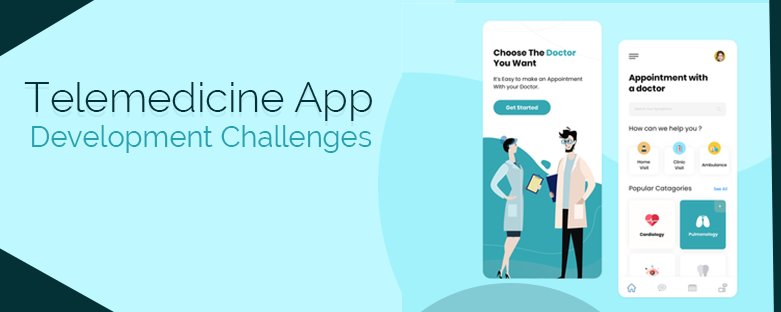Telemedicine App Development Challenges
Telemedicine app development Challenges is not a cakewalk and takes a high degree of skill and time to get it completed. The efficient phase of development still lets your own telemedicine project development remain one step ahead of others. There are still some Telemedicine Challenges during Development that developers and healthcare providers have to address to ensure technology growth.
We also developed a list of telemedicine challenges during the development as a Software Development Company for competitive companies with expertise in the implementation of digital health technologies.
The development of telemedicine applications, which are trend-setters in paving new forms of contact between a doctor and a patient, demonstrates the steady growth in the mobile app development company with an estimated annual pace of 35 per cent over the next few years.
Telemedicine App Development Challenges
Challenge 1: Backend Integration Practices
Good communication is required for an excellent telemedicine app. Both versions of the app would include backend integration, a separately built server that aims to mediate the sharing of data between both patient and provider apps, to ensure improved communication. To protect patient privacy, these data exchanges must be protected and completely in compliance with HIPAA guidelines.
Challenge 2: Ensuring the Best UI/UX while Telemedicine Development
According to the target user specifications, layout, navigation, and logic must be carried out. The user interface of a doctor’s app, however, and the user experience varies from the specifications of the patient app.
Each software will have two components when it comes to telemedicine applications, one for patients and another for physicians. Now, in developing these apps, it will not be easy for a developer team to guarantee a similar kind of ease.
A standardized UI / UX that acts as two separate components seamlessly and then gets beautifully incorporated is a challenge that will make all the difference in building a robust telemedicine app.
Challenge 3: Scalability
For its successful implementation, an outstanding telemedicine app development solution needs several features. One obstacle that most telemedicine apps developers ignore is the application’s scalability.
As the app becomes popular, an unforeseen increase takes place in demand and the user base. If the development team is not prepared to take on such a load, dealing with the situation becomes a problem.
Challenge 4: HIPAA Compliance Telemedicine Development
Telemedicine app development must understand regulatory requirements. Apps that handle patient information must be HIPAA compliant.
Here’s how to make your mobile app compliant with HIPAA.
The HIPAA Privacy Rule (Health Insurance Portability and Accountability Act ) provides requirements for the safety of medical records of individuals in healthcare systems, including telemedicine, making compliance with the HIPAA security rule a high priority issue for developers of apps.
Due to the possible security breaches and sensitive character of the exchanged data, the most secure data exchange protocols in strict compliance with all HIPAA specifications must be enforced within the communication between the apps.
Challenge 5: Security for Telemedicine Development
This is the most significant concern facing telemedicine apps, as confidential information is involved. Patients want to know that their information at all times is safe and stable. Encrypt and obfuscate all personal data that you send and receive, and use third-party servers that comply with all relevant laws and regulations in your target country to make your app safer.
Challenge 6: Payment/Billing Practices
A fully developed telemedicine app should be able to give patients the option of making safe payments by credit card or an insurance billing tool. Providers with 95 / GT modifiers and CPT / HCPCS billing codes should also be able to support the software during the actual billing process. Sometimes, this is better said than done.
Challenge 7: Selecting and using Trustworthy Telemedicine Software Developers’ Procedures
After deciding how to build telemedicine software, a reputable mobile app development company needs to be identified. You can either find an outsourcing company specializing in the development of telemedicine software or recruit an in-house app development team based on your financial capacity, ambitions, and business requirements.
Challenge 8: User experience
In the implementation of improved user experience, developers also face a significant challenge. Telemedicine is used for chronic decisions by patients, elderly people, and even pesos. The program is readily accessible and without a complicated interface for developers. For this, developers should strive to keep the app style uniform and design the app in such a way that the component in both parts of the apps is built. The developers should strive to provide a great user experience.
Challenge 9: Internet connection
Telemedicine facilities are provided over Internet-connected mobile devices. Among the other challenges is the speed of the internet. To set up a video call and a virtual visit, the Internet is important. Low speed and disruption contribute to inadequate care delivery and hamper the services of the provider in the provision of quality services.
Challenge 10: Healthcare legislation
The laws relating to data collection, storage, processing, and sharing may be subject to various regulations and laws, depending on the region. If you create your app for the US market, PIPEDA-for Canada, or the Data Protection Directive 1995/46 / EC and the European Union’s e-Privacy Directive 2002/58 / EC, read about HIPAA.
Those who are going to build telemedicine systems should select a development company that will construct a system that complies with regulations to protect the data of your patients and escape huge fines from the auditing authorities.
Challenge 11: Lack of trust
Apps of telemedicine also lack sufficient trust. In the more developed economies of the USA and Europe, these solutions are more common. Proof of physician integrity, a transparent evaluation system, and well-thought-out promotion will assist prospective users to gain interest.
Challenge 12: Monetary Compensation
A telemedicine parity law has been adopted by many nations, a central premise of which is that there must be the possibility of telemedicine service providers charging for remote patient services.
If the team can integrate safe card payment, Medicare insurance, different codes, and modifiers into the protocol of using the app, it will simplify the process for all parties.
Challenge 13: Lack of Insurance Options
Telecommunications rates can go from $15 to $75 even with insurance. Telemedicine applications provide a small number of insurance companies that are interested in it. For a visit, most users have to pay the full amount.
A larger range of patients will be benefited by applying the range of telemedicine insurance available.
What We Do for Telemedicine Development:
Being one of the leading telemedicine software companies in India, we empower hospitals, clinics, healthcare practitioners to develop HIPAA compliant telemedicine app development customized to deliver care from virtually anywhere, anytime!





This post contains lots of information regarding the development of a telemedicine app. Thanks for such kind of fantastic blog. Understanding the challenges of developing a telemedicine app is informative and helpful.
The best information is provided in this post. I read the whole post, and it’s fantastic. Thanks for this.